View in other NatureServe Network Field Guides
NatureServe
Montana
Utah
Wyoming
Idaho
Wisconsin
British Columbia
South Carolina
Yukon
California
New York
Graceful Sedge Grasshopper - Stethophyma gracile
Other Names:
Northern Sedge Locust
General Description
The following is taken from Helfer (1971), Otte (1981), Capinera and Sechrist (1982), Vickery and Kevan (1985), McDaniel (1987), and Capinera et al. (2004). A medium sized yellow green to olive-green grasshopper relatively free of markings, but a suffused dark stripe often occurs from behind the eye onto the dorsal edge of the pronotum. The forewings (tegmina) are long, extending beyond the tip of the abdomen and widening posteriorly. The hind tibia is greenish yellow with black spines and a dark marking at the apical third.
Phenology
Adults occur from July to September. No other data is presently available relative to overwintering, nymph occurrence and other aspects of its seasonal cycle (Capinera and Sechrist 1982, Otte 1984, Vickery and Kevan 1985, and Capinera et al. 2004).
Diagnostic Characteristics
The following is taken from Helfer (1971), Otte (1981), Capinera and Sechrist (1982), Vickery and Kevan (1985), McDaniel (1987), and Capinera et al. (2004). The body length to end of forewings is 25 mm to 29 mm for males, and 30 mm to 38 mm for females. Outer face of the hind femur yellow green to olive-green clear of any markings, but a red stripe occurs on the ventral margin and the inner face. A distinct conical tubercle occurs in the middle of the prosternum between the front legs.
This species could be confused as a Spur-throated Grasshopper (subfamily: Cyrtacanthacridinae) due to the distinct tubercle on the prosternum.
Species Range
Montana Range
Range Descriptions
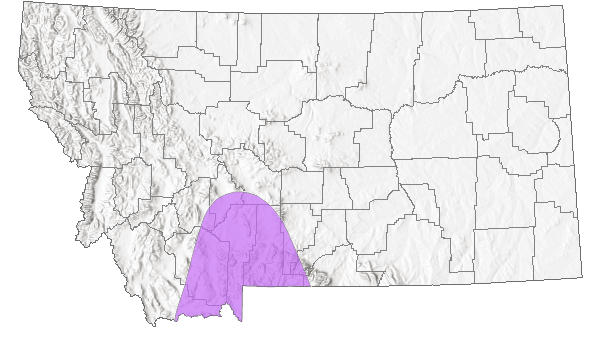
 Native
Native
Range Comments
Occurs widely east to west across Canada and the United States, extending southward to Colorado. In Montana it has been recorded in one county (Capinera and Sechrist 1982, Otte 1984, Vickery and Kevan 1985, and Capinera et al. 2004).
Observations in Montana Natural Heritage Program Database
Number of Observations: 4
(Click on the following maps and charts to see full sized version)
Map Help and Descriptions
Relative Density
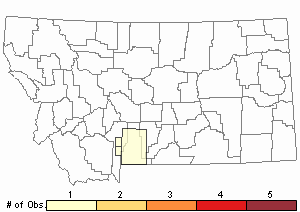
Recency
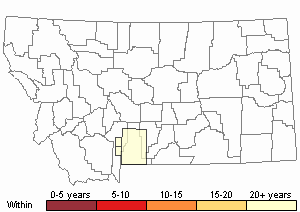
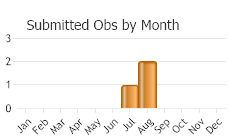
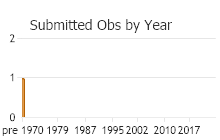
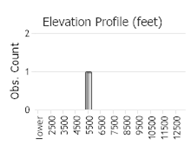 (Observations spanning multiple months or years are excluded from time charts)
(Observations spanning multiple months or years are excluded from time charts)
Habitat
Inhabits wet sedgy areas and thick grass, and rarely found far from meadows, bushy swamps, bogs, and ponds (Capinera and Sechrist 1982, Otte 1984, Vickery and Kevan 1985, and Capinera et al. 2004).
Food Habits
The Graceful Sedge Grasshopper is a grass and sedge feeder, but specific preferred host plant species have not been recorded in the literature (Capinera and Sechrist 1982, Otte 1984, Vickery and Kevan 1985, and Capinera et al. 2004).
Reproductive Characteristics
Courting males stridulate loudly and can be heard from many yards away and are considered more noticeable than any other grasshopper (acridid) that may be present in the vicinity. Presently, no other reproductive and life cycle observations have been reported in the literature (Capinera and Sechrist 1982, Otte 1984, Vickery and Kevan 1985, and Capinera et al. 2004).
Stewardship Responsibility
References
- Literature Cited AboveLegend:
 View Online Publication
View Online Publication Capinera, J.L. and T.S. Sechrist. 1982. Grasshoppers of Colorado: Identification, Biology, and Management. Fort Collins, CO: Colorado State University Experiment Station, Bulletin 584S. 161 p.
Capinera, J.L. and T.S. Sechrist. 1982. Grasshoppers of Colorado: Identification, Biology, and Management. Fort Collins, CO: Colorado State University Experiment Station, Bulletin 584S. 161 p. Capinera, J.L., R.D. Scott, and T.J. Walker. 2004. Field Guide to Grasshoppers, Katydids, and Crickets of the United States. Ithaca, NY. Cornell University Press.
Capinera, J.L., R.D. Scott, and T.J. Walker. 2004. Field Guide to Grasshoppers, Katydids, and Crickets of the United States. Ithaca, NY. Cornell University Press. Helfer, J.R. 1971. How to Know the Grasshoppers, Crickets, Cockroaches, and Their Allies. Revised edition (out of print), Mineola, NY: Dover Publications.
Helfer, J.R. 1971. How to Know the Grasshoppers, Crickets, Cockroaches, and Their Allies. Revised edition (out of print), Mineola, NY: Dover Publications. McDaniel, B. 1987. Grasshoppers of South Dakota. Brookings, SD: South Dakota Agricultural Experiment Station, Bulletin TB 89.
McDaniel, B. 1987. Grasshoppers of South Dakota. Brookings, SD: South Dakota Agricultural Experiment Station, Bulletin TB 89. Otte, Daniel. 1984. The North American Grasshoppers Volume II. Acrididae (Oedipodinae). Harvard University Press. 366 pp.
Otte, Daniel. 1984. The North American Grasshoppers Volume II. Acrididae (Oedipodinae). Harvard University Press. 366 pp. Vickery, V. R. and D. K. M. Kevan. 1985. The grasshopper, crickets, and related insects of Canada and adjacent regions. Biosystematics Research Institute, Ottawa, Ontario. Publication Number 1777. 918 pp.
Vickery, V. R. and D. K. M. Kevan. 1985. The grasshopper, crickets, and related insects of Canada and adjacent regions. Biosystematics Research Institute, Ottawa, Ontario. Publication Number 1777. 918 pp.
- Additional ReferencesLegend:
 View Online Publication
View Online Publication
Do you know of a citation we're missing? Bland, R.G. 2003. The Orthoptera of Michigan—Biology, Keys, and Descriptions of Grasshoppers, Katydids, and Crickets. East Lansing, MI: Michigan State University Extension, Bulletin E-2815. 221 p.
Bland, R.G. 2003. The Orthoptera of Michigan—Biology, Keys, and Descriptions of Grasshoppers, Katydids, and Crickets. East Lansing, MI: Michigan State University Extension, Bulletin E-2815. 221 p. Hebard, M. 1928. The Orthoptera of Montana. Proceedings of the Academy of Natural Sciences of Philadelphia, Vol. 80:211-306.
Hebard, M. 1928. The Orthoptera of Montana. Proceedings of the Academy of Natural Sciences of Philadelphia, Vol. 80:211-306. Kirk, K. and C.R. Bomar. 2005. Guide to the grasshoppers of Wisconsin. Madison, WI: Wisconsin Department of Natural Resources, Bureau of Integrated Science Services PUB-SS-1008. 154 p.
Kirk, K. and C.R. Bomar. 2005. Guide to the grasshoppers of Wisconsin. Madison, WI: Wisconsin Department of Natural Resources, Bureau of Integrated Science Services PUB-SS-1008. 154 p. Otte, Daniel. 1981. The North American Grasshoppers. Volume 1. Acrididae (Gomphocerinae and Acridinae). Harvard University Press. 275 pp.
Otte, Daniel. 1981. The North American Grasshoppers. Volume 1. Acrididae (Gomphocerinae and Acridinae). Harvard University Press. 275 pp. Scott, R.D. 2010. Montana Grasshoppers, Katydids, and Crickets A Pictorial Field Guide to the Orthoptera. MagpieMTGraphics, Billings, MT.
Scott, R.D. 2010. Montana Grasshoppers, Katydids, and Crickets A Pictorial Field Guide to the Orthoptera. MagpieMTGraphics, Billings, MT.
- Web Search Engines for Articles on "Graceful Sedge Grasshopper"
- Additional Sources of Information Related to "Insects"





